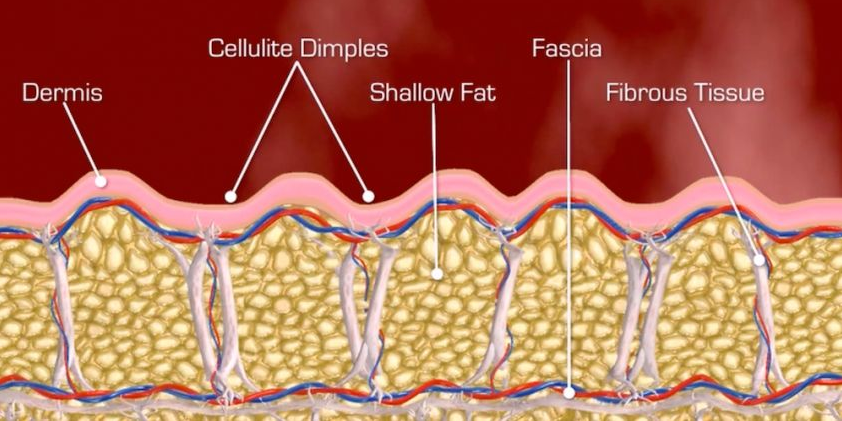Fibrous septae are among the causes of the “visibility” of cellulite. These thickenings of fibrous tissue are part of the structure of cellulite. Precisely the structure of cellulite is the last frontier for treatments which, thanks to research and innovation, give more long-lasting results without resorting to scalpels. Cellulite affects the overwhelming majority of women, usually after puberty. Many believe that cellulite is a problem caused by fat and can be eliminated with diet and physical exercise. Experience leads to other conclusions: it is possible to reduce the appearance of cellulite if weight is lost, but it is not possible to get rid of it completely. And some diets may even make the situation worse.
What are fibrous septae?
Fibrous septae are thickenings due to the alteration of cellulite structure, especially in certain areas of the body. Fibrous septae are like narrow, rigid bands that pull the skin downwards, thus creating the typical effect of cellulite on the surface of the skin.
Why act on fibrous septae?
According to some experts, severing the fibrous septae allows the skin’s surface to smooth out; the result is a long-lasting improvement in the appearance of cellulite.
Cellulite, structure and fibrous septae: But it is not a problem of overweight
There are many more or less scientific descriptions that lead to different interpretations of the causes of cellulite formation. Among these there is also one that describes how cellulite forms due structural alterations. Cellulite is formed because there is also a structural problem under the skin that only a doctor can treat.
What is behind the definition of cellulite as an alteration of the structure of adipose tissue?
To better understand what cellulite is, a notion of skin anatomy is necessary. The outermost layer of skin is the epidermis. Immediately below the epidermis is the dermis.
The dermis is rich in:
- hair follicles
- sweat glands
- blood vessels
- nerve receptors
- connective tissue
The anatomy of cellulite is now well-known thanks to magnetic resonance imaging and is the basis of research aimed at counteracting cellulite at the structural level. For many experts, the problem is structural and caused by histological and biochemical alterations in the adipose and dermal tissue.
Cellulite is thought to be the result of complex mechanisms that are manifested in different ways depending on their evolution in adipose tissue:
- increase in adipocytes
- increase in the volume of adipose cells
- alteration of the shape
- decrease in adipose tissue
- cell thickening
- neoformation of collagen fibres
- encapsulation of degenerated adipocytes
- formation of micronodules
- evolution into palpable, visible macronodules
- hardening of the connective fibrous septae
- stretching of the skin down towards the deep layers
- formation of craters which cause the typical “dimpled” effect
All the fault of fibrous septae? Why women have cellulite and men don’t
In women, the fibrous septae are perpendicular to the skin surface in rectangular sections.
When there is an alteration to adipose tissue:
- the volume of lobules and trabeculae increases
- collagen fibres become sclerotic
- the compression of adipose tissue increases
- orange peel skin can be seen
On the other hand, in the subcutaneous tissue ofmen :
- fibrous septae are arranged in a rhomboid manner
- the lobules with a polygonal shape
- do not invade the dermis (even in the case of large fat deposits)
Hormonal differences between genders largely explain these differences in skin structure. According to some studies, men who are born with low concentrations of male hormones often have the appearance of subcutaneous fat cells similar to females.
What is the role of connective tissue in the dermis?
The connective tissue of the dermis serves to maintain:
- structure
- isolation
- stability
of the subcutaneous dermis.
The connective tissue is mainly composed of:
- collagen which gives tensile strength
- elastic tissue that gives the skin the ability to stretch and return to normal
Fibrous septae: the enemy
The most innovative treatments attack the structure of cellulite and therefore the fibrous septae, giving results that are:
- clinically tested
- more long-lasting
Fibrous septae: What are the causes of cellulite?
There are 3 structural problems that cause cellulite:
- The fibrous septae thin and stiffen
- Fat increases in volume and is trapped and retained by the fibrous septae
- The skin thins and worsens the appearance of cellulite
Other factors associated with cellulite are:
- ageing
- heredity
- hormones
- weight
- gender
This is why, more than fat, any effective cellulite treatment must tackle the structure of cellulite in order to achieve more long-lasting results.
Fibrous septae: tissue stabilized guided subcision
This treatment, approved by the FDA and with EC certification, acts through non-surgical excision of the fibrous septae, improving the appearance of orange peel skin with the least side effects for a long time.
It is an outpatient treatment, under local anaesthesia, lasting 45 minutes. Results can last up to 2 years, but you have to be aware that it is a treatment that only reduces the appearance of cellulite and has no lifting or reducing effect. It is essential to contact an expert doctor or plastic surgeon who works in accredited facilities.


